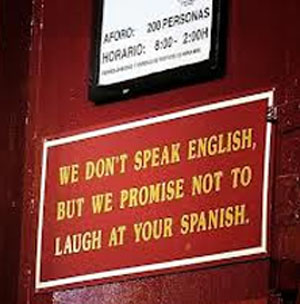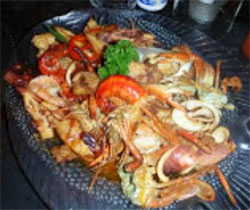|
|
|---|---|
Edition 78- February 2015 Published at Quepos, Canton of Aguirre, Province of Puntarenas, Costa Rica (© Copyright 2015 - All Rights Reserved) |
Broken News
(All the News That's Fit to Reprint)
Throwing the Bull
At various times and festivals throughout the year, "running the bulls" becomes a fun activity for some Ticos.
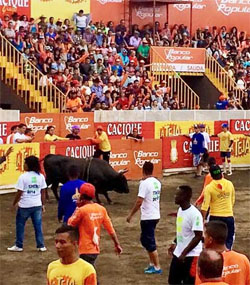 |
How to Irritate a Bull - Let's All Gather Around Señor Toro and Taunt the Hell Out of Him |
Note that we're not talking about the running of the bulls like in Spain where people run willy-nilly in front of the beasts to avoid being gored. Here it's perhaps more accurate to say it's the taunting of the bulls; others simply call it bull baiting. Anybody drunk or sober, and there are many of both, who'd like to get into the ring with Señor Toro is welcome (see photo). GG's first experience with this sport was in March of 2010 when he attended the Quepos festival held at the Paquita fairgrounds just north of the city (see Festival Time - Bull).
Taunting of the bulls is particularly popular around Navidad and this past Christmas was no exception.The first bull (the one in the photo left) was released on schedule in Zapote, a barrio of San José, Christmas Day afternoon. The bull baiting will continue through January 4 and contenders pay up to 25,000 colones (about $47) to get the chance to be gored. I'm not sure where the money goes or if there are cash awards for throwing the bull. The event at Zapote became even more interesting when a band on a flatbed was rolled into the arena to play toreador music as the bull chased the tauntors (called toreros improvisados) about the rondel (ring). Dude, what fun!
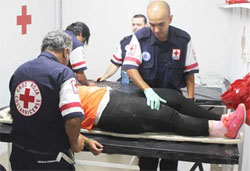 |
Cruz Roja Treating the Gored |
Well, not for everyone. The good news is that authorities have gotten better at preparing for the inevitable side effects that come with tormenting toros. The Cruz Roja (Red Cross) had emergency vehicles and EMT staff at the Zapote arena as well as at a similar event in Pedregal, a town on the Nicoya peninsula.
At the half way point of the 11-day event, some 80 people had been treated for injuries at the two locations, mostly bruises from horns but almost two dozen injuries were serious enough to hospitalize the victims. None of the injuries so far were reported as life threatening.
Update after the holidays: The final total of injuries reached 397 with 78 requiring treatment at clinics or hospitalization. In all likelihood their were more than this unofficial count as all events aren't officially reported. Thank God no fatalities were reported although some of those injured will be carrying their scars for the rest of their lives.
At least the lack of fatalities was better than the report on other violent deaths during the Christmas-New Year's period; 27 in vehicle mishaps and 22 murders, both between December 19 and January 1. That count is accurate and official because all violent and "unattended" deaths have to go through the national morgue in Heredia. GG is familiar with that facility because he claimed the body of an ex-pat friend there in October of 2013 whose cause of death (likely a heart attack) in Quepos was "unattended" (and unexplained by them).
Postage for Progeny
The Correos de Costa Rica (Post Office) loves to be creative when designing its stamps and particularly likes to include something about Costa Rican culture. The postage stamps below were issued in time for Christmas and carry the heading "Sobretasa Pro-Ciudad de Los Niños", meaning that the cost of the stamp will be donated to Kids City, a boys home in Cartago. Depicted in the poster are 20 classic Costa Rican meals.
How many dishes with beans and rice can you find, boys and girls?
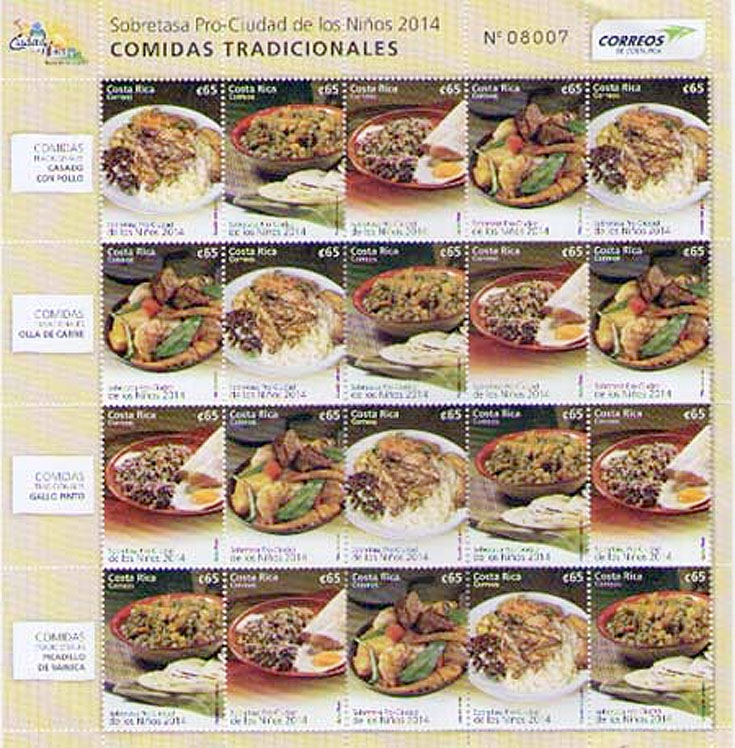 |
¡Buen Provecho, niñitos y niñitas!
Costa Rica Trying to Save the Americans!
This is the "high" season. i.e., the most popular time for an influx of tourists in Costa Rica, most of them coming from North America. The Instituto Costaricense de Tourism (Costa Rican Tourist Institute) has put together a video that reminds norteamericanos, particularly workaholics and those that think they are workaholics that relief is only a few hours away. Check out ICT's video here (only 2 minutes):
Weem-away, weem-away!
Rumble Talk
(Shaky Happenings On or About the Pacific Rim)
A reader and friend brought GG's attention to the fact that the weather channel had concocted an animated video that shows all the earthquake activity in the world over the last ten years. To see the video, which takes only 3 minutes, click on the link below. As you watch it, the size of the circle indicates the strength of the tremor and the color designates the depth below the surface, red being the shallowest depth, not more than 25 kilometers. Note two things: 1) the activity easily defines the most active area in the world, known as the Pacific Rim and 2) note that the frequency in Central America, including Costa Rica is one of the strongest outside of southeast asia.
10 Years of Earthquakes in Three Minutes
| Check Out Recent Earthquakes Around the World Posted by the U.S. Geodetic Survey: Today's Quakes |
|---|
Potholes and Wormholes
(Los Huecos of Costa Rica and Avoiding Falling Through the Universe)
Potholes (los huecos - pronounced hwaykos in Spanish) happen in most countries and Costa Rica is no exception, in fact some like to think the problem is worse here due to lack of maintenance. That may be partially true as the country has limited funds compared to a fully developed country, and the heavy rainfall certainly takes its toll, but things are getting better. God knows that the road infrastructure here now is significantly better than it was only five years ago.
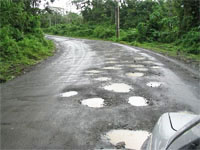 |
A Costa Rican Secondary Road
in Rainy Season |
GG lives in a small town, Quepos, and the side streets, including the one in front of his apartment, is regularly spotted with potholes no matter how hard the street department tries to compact the gravel in the road. They recently redid the sewers with bigger drainage pipe and rumor has it they might actually pave the street with asphalt (it's one of a handful of downtown streets in Quepos that hasn't yet received some paving). Will that solve the problem of potholes? Not completely, but it will help.
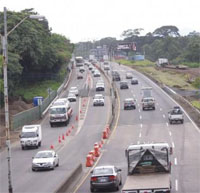 |
A Famous Pothole Scene in San José - Autopista General Cañas |
Potholes are formed by water, whether in northern or tropical climes. In the northern regions of the U.S. like Massachusetts, where GG grew up, many potholes are formed when the wet ground under the paved surface freezes in the winter and then thaws in the spring and vehicle traffic cracks and displaces the pavement The effect is enhanced when the thawing is quick. In Costa Rica nothing freezes but we receive 4-5 times the annual rainfall (see Singing in the Rain) than that of a place like Massachusetts; and it's concentrated into seven months of the year (mid-May to mid-December).
One of the more famous potholes in Costa Rica opened up on the four lane General Cañas autopista (freeway) in June of 2012 not far from Juan Santamaria International Airport, causing major traffic jams in the area. This autopista is the main artery connecting the greater San José area with the main airport. It was the rainy season and a large drain pipe that ran under the autopista got clogged up with branches and other debris; then the overflow washed out part of the highway.
MOPT (Ministerio de Obras Publicos and Transportes - the Costa Rican DOT if you will) estimated repairs would take three and a half weeks. A quick repair with a bailey bridge to restore traffic encountered problems when the bridge collapsed under the weight of some heavy equipment. The span was eventually replaced with a new bridge; resurfacing on an "emergency" basis took 4-1/2 months.
When a pothole gets out of hand, they call it a sinkhole. The same forces are at work; underground water flow that undermines the surface and anything on top of it. Sinkholes have been known to swallow cars in the middle of the night, sometimes driver and car are never to be seen again. One sinkhole in Guatemala in May of 2010 opened up and swallowed a three story clothing factory (see picture below). The hole was at least 200 feet deep and one man went missing.
Some Major Sinkholes Around the World |
||
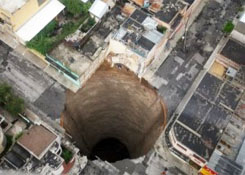 |
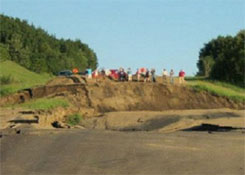 |
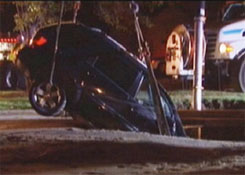 |
Guatemala |
Manitoba, Canada |
Michigan |
So when GG picked up a recent local press report with the following headline, he was immediately intrigued:
"Bottomless Costa Rican Pothole Could Be Time Travel Portal"
Say what? A picture of a huge sinkhole was shown. I was captivated, and the article went on to say:
"Top physicists from around the globe will convene to investigate the bizarre phenomenon that was discovered at the bottom of a gaping pothole in front of the Taco Bell in Curridabat last week. Theoretical physicist Stephen Hawking, who will head the conference, believes it could be the universe’s first proven wormhole into a quantum world that links separate places and times. “THIS IS PERHAPS THE MOST ENCOURAGING DEVELOPMENT IN TIME TRAVEL.” Hawking said through his computer voice simulator. “WE MAY HAVE FOUND AN AVENIDA SEGUNDA INTO OTHER GALAXIES.”
It was the last bit about Hawking (a known theorist on wormholes who believes time travel may be possible) that finally made me understand that the article was a satire dreamed up by some spoof magazine called El Pejibaye, “Costa Rica’s Most Nutritious News Source”. (For more on the unusual fruit, Pejibaye, see The Peculiar Pejibaye). The picture of the wormhole they used was the one from the Guatemala incident in 2010 so nothing actually happened at the Taco Bell in Curridabat. Shucks.
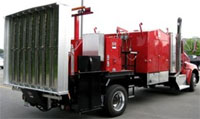 |
KASI Infrared Pothole Fixer |
Before any more potholes in Costa Rica turn into wormholes we may be able to check their progress by use of a new technology. A company in Claremont, New Hampshire called KASI System Corporation has developed an infrared based curing system that's mounted on a truck. The truck carries enough of it's own asphalt for a day's activity as well as a bank of infrared lights. It produces a cured asphalt that is more permanent and stronger than conventional methods and it does so at half the cost and time. Says their literature: "We can do a typical 5x7-foot repair in less than 20 minutes with no traffic disruption." Dude, kool, especially the last part; that's the American way, cheaper, faster, better.
Costa Rica often is a recipient of the generosity of other countries in the form of police vehicles (China) or Coast Guard boats (U.S.). If I were at the top of Tico politics I'd be asking please that the next batch of vehicles include a half dozen KASI Trucks. It's not clear from published information what the unit cost of these vehicles is but just looking at the photo, my guess would be less than $200,000 each (basic time-travel transporter not included - ask for current market price). Chump change in international largesse.
I'm done - beam me up Scotty.
Montevideo
(Visiting the Capital of Uruguay)
During his visit to Buenos Aires in November, the opportunity presented itself to the Golden Gringo to take a one day tour of Montevideo, Uruguay. He took advantage of it and this is his report.
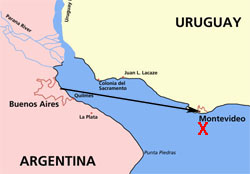 |
Recall that Montevideo and Uruguay are basically across the mouth of the Rio de la Plata estuary from each other. The mouth at the widest point is about 90 kilometers or 45 miles. The locals on both sides constantly and proudly refer to it as the "widest river in the world". Methinks it's really a bay but why quibble.
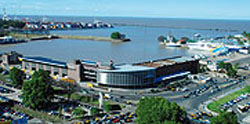 |
The Buquebus Terminal Buenos Aires |
The plan I signed up for was the BuqueBus (bookey-boos) Tour which is a combination of a catamaran to take us between the two ports and then a bus tour of Montevideo. We were advised to show up at the Buquebus Terminal at the north end of the Puerto Madero dock area in Buenos Aires at 7:30 AM for an 8:30 departure. I was there shortly after seven and that was a good thing, for there were at least 200 people in a dozen lines checking in. After processing through the ticket check-in area and going through passport control to exit Argentina, we simply walked on board and chose our seating which was first come, first served. It departed on schedule.
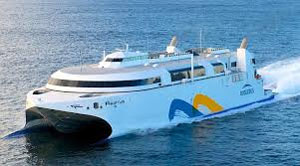 |
Buquebus "Francisco" |
The boat we boarded is called the "Francisco" and is a large, heavily-powered catamaran. The Francisco is the newest ship in the Buquebus fleet of nine ferries and was named after Argentine-born Pope Francis. Later, I found that the distance from Buenos Aries to Montevideo, per Google ruler, is about 200 kilometers or 120 miles straight as the giant catamaran cruises, which makes the trip more impressive in that it only took us about two and a quarter hours. Could it really have been moving nearly 60 miles an hour or did the time change confuse me? (Montevideo is an hour later)
When the ship came back to Montevideo late in the afternoon to pick us up, and before I knew the ship's stats, I counted, from an upstairs window of the terminal, the cars that it disgorged - a total of 108 and about 400 people to boot. Its immense size contributes to the feeling that it's only going 25 miles per hour or so.
Later I checked the stats on this impressive ship and found out that, indeed, it's rated cruising speed is 107 km/hr (58 knots or 64 miles per hour). Holy choripan, Robin, that's faster than many smaller speed boats! The Francisco has a capacity of 1,024 passengers and 150 cars. It's dimensions are: Length - 99 meters/327 ft, width of 26.9 meters/89 ft, waterline length of 90.5 meters/299 ft, draft of 3 meters/10 ft and a deadweight capacity of 450 tons. It's also energy efficient and "green" in that it runs on liquefied natural gas.
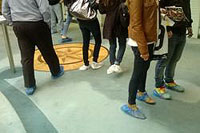 |
| Plastic Booties |
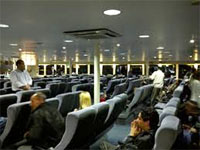 |
Buquebus Tourist Cabin |
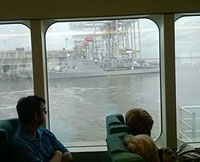 |
Uruguayan Navy Ship |
The Francisco is a very comfortable ship. Buquebus is very proud of it and wants to keep it in good condition. As we entered the walk-in ramp of the boat we were required to step into a small device that automatically clamped little plastic booties over our shoes - wouldn't want to soil the plush carpeting, would we? Then GG and other tourist class peons made their way upstairs to the tourist lounge and took a seat. The seats were larger, better padded and had more space between them than any airline seat I've ever been in with the possible exception of a Boing 777 business class.
Those passengers more in the know than I, had already selected the window seats by the time I got there so I was a bit disappointed. But it turned out to be a rather hazy day anyway and not much could be seen from the windows (basically the trip view is mostly water anyway). And there was another lounge area outside the (very large) duty free area on the tourist cabin level that had windows for viewing where I hung out for a while. Haziness and mostly calm water dominated the view in any direction.
People told me it's not always calm on the Rio de la Plata. The guide on a previous tour to La Tigre told us that with a strong southerly wind, the bay (errr, excusé moi, the river) can raise ten foot swells and push a 6 foot wall of water up the Paraña and Uruguay rivers causing some flooding whereas a strong northerly wind works oppositely and can lower the rivers significantly.
Half way through the trip I saw a money exchange kiosk one deck down and decided to get some of my Argentine Pesos turned into Uruguayan Pesos. The tour was all paid for and included lunch but I think it's always nice to have a few "bucks" in the local currency, although I later learned they have little trouble taking Argentine pesos in Montevideo. Two hundred Argentine Pesos got me 360 Uruguayan Pesos or about $15 worth, enough for gum or a coke.
I inquired about an observation deck with the staff of the Francisco (the photo of the ship shows a small, open top deck) but was told passengers were not allowed there for security reasons. In retrospect, it occurred to me that, if we were moving at 65 miles per hour into a 20 knot wind, I could have easily been blown overboard and ended up as driftwood on a beach in Rio somewhere. Good security call, Buquebus amigos.
When we arrived in the port area of Montevideo the captain of the Francisco used a myriad of thrusters to ease the large cat into a slip across from what looked like a light cruiser of the Uruguayan Navy. Capo never hesitated and had us docked within ten minutes and disembarked within twenty. We then got to pass through Uruguayan immigration with little fanfare or delay and made our way to our respective tour buses, or for those that were coming home, to their cars.
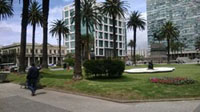 |
Center Square Montevideo |
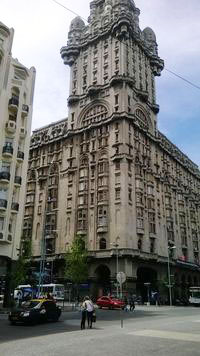 |
A Corner of Center Square |
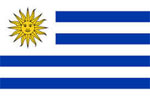 |
The Flag of Uruguay |
Compared to Argentina, Uruguay is a much smaller country, both area wise (68,000 square miles vs 1,000,000) and in population (about 3.5 million versus 41 million). Nevertheless, better than half of Uruguay's population or close to two million people live in the greater Montevideo area. The city is often described as a laid-back Buenos Aries and it seemed to GG to have exactly that feel; less busy, less rush-rush. I noticed the almost total lack of traffic signals throughout the city; they were installed in a handful at the busiest intersections in the central district only.
The guide told us the name Montevideo comes from the fact that the city is perched on six hills and could easily be seen by ships on the Rio de la Plata.
It was a slow day for the city tour; the tour bus I was on had only seven people including GG, in addition to the guide and driver. As we set off on our comfortable bus, our guide asked for languages and he judged by our responses that it should be English for me and Spanish for all the others. His English proved rather good. We headed for the main center square of the town, which turned out to be a park surrounded by modern office buildings but also included some classic Spanish architecture (see photo right).
One of the buildings on the square is the national congress building (in the photo top right, it's the two-story building center left). The guide told us there have been two items on the congressional agenda that have caught the news lately: 1) Uruguay passed the first law in Latin America sanctioning gay civil unions, and 2) they are expected to pass legislation soon that not only legalizes the farming of marijuana but makes it a government operation - the country is looking for it to be a big cash crop and industry (how laid-back do you want to get?).
After about an hour of touring, including the obligatory viewing of at least three football stadiums (one used to do cathedrals this way, at least in Europe; today it's futbol). We were deposited on a street near the center in front of the El Fogón restaurant which was our designated lunch place and included in the tour.
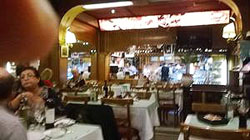 |
Restaurant El Fogón |
El Fogón is a parrilla - grilled meat once more. No matter which side of the Rio de la Plata you're on, scorching animal flesh is de rigueur (it's difficult to see in the photo left but the back end of the restaurant is a large open grilling pit). As part of the tour, we were entitled to three courses from a reduced but still ample menu. I saw lamb and asked for it but they were out, so I had to settle for a large t-bone steak (this tourist thing sometimes means sacrifice).
After an hour and a half for our leisurely lunch we reboarded the bus and headed south, passing through Carrasco, which the guide told us was the most affluent neighborhood in the city. It was kind of a modest replay of the Palermo district in Buenos Aires. The guide said houses in Carrasco go for as much as US$2,000 per square meter (a little less than $200 per square foot). After an hour or so and short delays to review two more football stadiums we headed back north towards the city but this time we motored along the coastal highway.
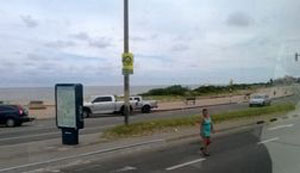 |
A Montevideo Beach |
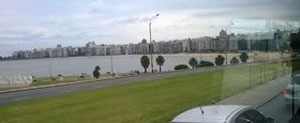 |
Southbeach - Montevideo Style |
 |
Punta del Este Car Plate |
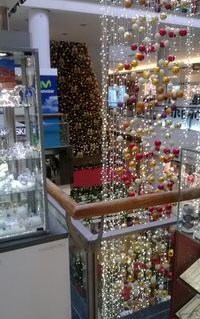 |
Xmas Was in Full Swing at Punta Carretas Mall |
Had we gone south, in about an hour and a half we would have reached Punta del Este at the tip of the Uruguayan peninsula. Punta del Este is considered the Miami Beach of Uruguay with a permanent population of about 10,000 during the off season but over 100,000 when the tourists come in the summer (January-March - close to the same season as Costa Rica).
Returning along the coast line to Montevideo there were many beaches and some sections were bordered by a few miles of high-rise condos reminding me more of Miami Beach (right), at least from a distance.
In order once more for the tour company to maximize our exposure as tourists to potential expenditures, we were discharged at the Punta Carretas shopping center on the south side of the city in the affluent zone for an hour and a half of "free time". The most interesting thing about this mall was that it had been a prison in an earlier life (talk about having captive audiences for commercial purposes) but the building has since been modernized.
GG didn't have an interest in shopping, even though the mall was already decked out for Christmas and had virtually all kinds of stores. Instead, I walked the three or four blocks down the hill to the waterfront and stuck my hand in the Rio de la Plata to check the temperature. My guess is it was in the mid to high sixties Fahrenheit - a bit chilly for the golden one who is used to the high seventies to low eighties in Manuel Antonio. Still doable in a pinch though.
After the mall we returned to the bookey-boos (I love saying that) terminal and picked up the return trip on the Francisco. We departed around 7:30 PM Montevideo time arriving BA just before 9:00 and gaining our hour back. After processing through passport control where I had to show my original "reciprocity visa" for U.S. citizens visiting Argentina, I encountered some enterprising cab drivers outside the Buquebus terminal who wanted to take advantage of the later hour and told me it would be 200 pesos or $15 to anywhere in the downtown area. I balked, and now knowing Buenos Aries better after three weeks, walked a few blocks where I picked up a regular taxi that whisked me back home for 50 pesos.
The Golden Gringo was starting to feel comfortable in the big city.
The Montevideo tour is not for the faint of wallet - it cost 2,700 pesos or just about US$200 for the day. But that included the fabulous ride on the Buqeubus, the tour, a great lunch and the fun that comes from being in a new country and meeting new and different people.
I will remember it for a long time to come.
¡Viva Uruguay!
Getting Down with Squid
(Cooking Class in the Rainforest)
A friend recently asked if GG would be interested in joining a one day cooking class near Dominical, about 26 miles south of Quepos. "Absolutely", says I.
This was a one day outing into a mountain area about six kilometers south of Dominical called Escaleras (see What's-in-a-Word section below). After the usual but not long bumpy ride up a typical Costa Rican country road, we arrived at the instructor's home and cooking school in the Escaleras area, situated high on the mountain looking towards the Pacific Ocean. We were greeted by Nate, one of our hosts and told that his partner Ben would be the instructor that day.
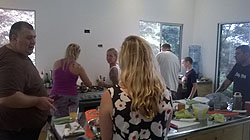 |
Cooking Class at Work (L to R: Jason, Litaka, Amy, Marion, Ben -the Chef, Lucas, Nate; GG is Behind the Camera) |
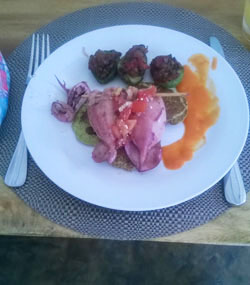 |
Finished Main Course |
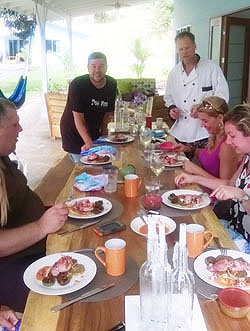 |
Class Digging into the Finished Product (That's Nate and Ben, our Hosts at the End of the Table) |
We were each given a cutting board and knife and instructed in the better and safer ways of holding a knife for assuring we cut the product and not ourselves. Ben then reviewed some dozen or more components of the meal he had listed on a white board and that we would jointly be preparing. We then paired off and began at the top of the list while Ben made assignments.
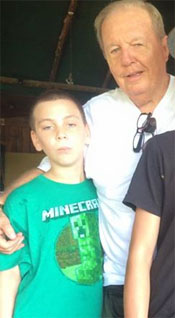 |
Future Chef Lucas |
Our youngest class member was Lucas, one of class member Jason's htree sons. Lucas is an aspiring chef and was eager to participate, flitting around the room and engaging in any activity he was assigned or could participate in.
My partner (Marion) and I were first responsible for making the stuffing that would be used for the calamari. We seeded and chopped tomatoes and red onion into something that resembled a chimichurrie, then added fresh chopped basil. To crown the stuffing, Ben added some crumbled feta cheese.
We were all instructed in the proper cleaning of calamari, first sticking a finger down the tubular stomach to remove the insides, then removing the spine and "feather" that runs down one side of the pouch, then squeezing out the ink, which was brown and gooey (hey amigos, this is not for the faint of heart). The head is then cut off in such a way as to keep the tentacles (except the two longest ones which are actually "feelers" - they're discarded) and then a little beak near the head is removed.
Tapenade is a Provençal dish consisting of puréed or finely chopped ripe olives, capers, anchovies and olive oil. Its name comes from the Provençal word for capers, i.e., tapenas. We all munched on melba toast covered with tapenade as we prepared the other components.
Also prepared was a vegetable accompaniment consisting of chayote, those small green squashes we have and love here. After scraping out the centers they were stuffed with a duxelle of mushrooms and baked.
One other component was added to the dish in the form of: zucchini that was shredded, combined with a batter and made into small pancakes upon which the squid, two to a plate, were mounded. Check the photo left which portrays the final dish with the pancakes (green), squid (pink) and stuffed chayote (brown). The orange sauce is a puree of roasted red pepper and mango. Delicious.
For desert we made a pumpkin bread but the batter was such that it was nearly as much a pudding as a bread. It was drizzled (glazed) with a sauce of cream containing the core of a fresh vanilla bean. Yummers.
Look amigos, we may be in the rainforest but we have plenty of kool raw materials from which to fashion a good meal. And one can always benefit from the knowledge of how to use new cooking techniques.
I'm looking forward to another class.
Travel Quote of The Month |
|
What's-in-a-Word
Huecos
El hueco, Hway-ko. As an adjective: 1) hollow, 2) resonant, hollow (sound), 3) empty (without an idea). As a masculine noun: 1) hole (cavity), 2) recess (in a wall)
Sayings:
1) spare moment: te puedo hacer un hueco, -a esta tarde (I can squeeze you in this afternoon)
2) no había ni un hueco, -en el teatro (there wasn't an empty seat in the theater)
3) hazme un hueco, -en el sofá make a bit of room for me on the sofa
4) la marcha de los hijos dejó un hueco, -en sus vidas the children leaving left a gap in their lives
Escalera
La escalera; es-kah-ler-a, feminine noun, ladder or staircase.
Examples:
- escalera de caracol spiral staircase
- escalera de incendios fire escape
- escalera mecánica escalator
- escalera de servicio service stairs
- escalera de tijera step ladder
ROMEO Corner
(Retired Old Men Eating Out)
Jiuberth's Marisqueria - Quepos
Location: Approximately 2 kilometers east from Pali towards the hospital and Naranjito and 150 meters in on an access road to the left (there's a sign on the main road).
Hours: Lunch and Dinner
Parking: Sufficient at the restaurant
Contact: Tel.: N/A; Email: N/A; Website: N/A
Reviewing ROMEOS: Alice M., Alma L., Joanne H., Roger H., John S., Mary M., Lance M., Bob N.
To Review Our Rating System and Procedure, go here: R.O.M.E.O. Rating System
This place is definitely off the beaten track but worth the effort to find it. As the name implies, it is a seafood restaurant primarily dedicated to all the goodies of the ocean. The menu also has a pork filet and maybe one other main dish that is not seafood but if you want meat, this is probably not your place of first choice.
Jiuberth and his family have been in the seafood and fishing business for many years. His son Renier operates the Kúkula restaurant in the Boca Vieja region of Quepos where the original family restaurant was founded. The ROMEOS reviewed the Kúkula back in June of 2013 giving it four sloths, 3.5$ cost rating and a value index of 114. See Kúkula. Good seafood eating runs in the family.
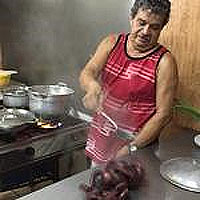 |
Papa (Jiuberth) in Kitchen |
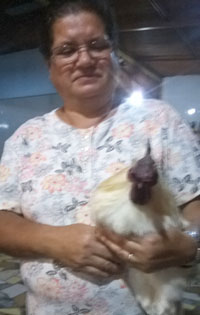 |
Mama and Señor Pollo |
This is a mom and pop operation at its best. Papa (Jiuberth) is in the kitchen preparing all the dishes with care and mama is serving. We were given a tour of the kitchen to meet Jiuberth and to see the mounds of shrimp, prawns, mussels, langoustines and lobsters waiting for his attention.
After the tour, mama introduced us to the family pet chicken who spent some time roosting on the wooden railing behind our table. "What's his name?" asked GG. "No se, no nombre, señor"; doesn't really have one - sounds to me like señor pollo is living on borrowed time hanging around too close to a very active kitchen.
The restaurant is decorated simply but tastefully with what might be called local knickknacks, and it is very clean. The tables are bare and the seating is stereotypical tico hardwood (a back-breaker for GG). Small irritations came from the large number of mosquitos that attacked us while we attacked the food and a mysterious and not so pleasant weak odor that permeated the area. For atmosphere we give Jiuberth's three and a half sloths.
The one page menu is an exercise in simplicity, offering a couple of dozen combinations of 6-8 basic seafoods such as shrimp, prawns, fish, squid, mussels, langoustines and lobsters. The offering that caught GG's eye was the Mariscada, a melange of all the seafood on hand. Other ROMEOs chose single seafood plates like shrimp or calamari done in butter and garlic. The amount of extremely fresh seafood delivered (see photo) was extraordinary and I needed two other ROMEOS to help me finish it. For dessert - well, there was no offering for dessert (not to worry, the ROMEOS found their way to good POPS ice cream in Quepos later). |
 |
||
|---|---|---|---|
$$$1/2 |
|||
Value Index:
|
For food quality we give Jiuberth's our highest rating, five sloths.
If you measure service by gringo standards, we'd have to get critical but how do you argue when a sweet grandmother serves you, especially when she also gives chicken demonstrations. For service we give Jiuberth's four sloths. That results in an overall rating for atmosphere, food quality and service of four and a half sloths.
With two soft drinks and that huge mariscada, my tab came to 17,200 colones (about $31) after tax and legally-required gratuity were added in (I've paid 18,000 and change for soggy lasagna and dried out chocolate cake in Manuel Antonio before). The average of four single plates came in at about 8,800 colones or around $16. Considering this was all seafood, that puts Jiuberth's at around a three and a half $ cost rating and a value index of 4.5/3.5x100 = 129, in the top third of our list.
So if you love seafood, Jiuberth's is the place for fresh seafood at a reasonable price.
Golden Gringo Chronicles Novel and E-Books Now Available!
The story of the Golden Gringo Chronicles is also available as a hard copy novel of 192 pages available through Amazon and all major online retailers. ($9.95) Amazon link: GGC, the Book. (Kindle Edition available) Follow GG through the first six years of his odyssey in making the decision to retire in Costa Rica, overcoming the trials and tribulations of moving and obtaining residency there and the fun and experience of actually living in Ticoland. Ride along with the Golden Gringo as he learns about the rich, varied culture of Costa Rica, the incredible bio diversity, the charming nature of the Costa Rican people and the ease with which a sometimes clueless ex-pat can assimilate into a small southwestern town on the Pacific coast. Whether you are already a Costa Rican resident, someone contemplating a move here or just a traveler who enjoys different cultures, you will find the Golden Gringo Chronicles interesting, entertaining and informative about Costa Rica.
A narrative version of the Golden Gringo Chronicles is now also available as a trilogy of E-books in formats compatible with virtually all electronic platforms. Click on Part Number above for E-book sample downloads or click the price above right for purchase. (The best price is on Part 1; it's FREE) |
don Beto de Quepos,
El Gringo Dorado Pura Vida! |
Be pithy but kind; I'm sensitive. |
|---|










